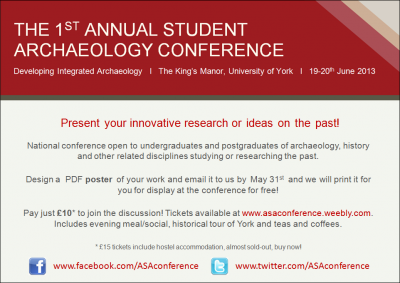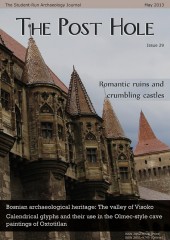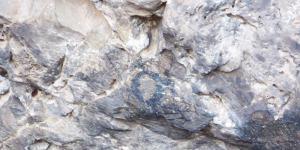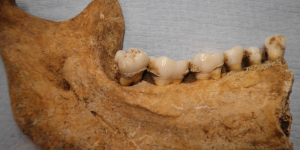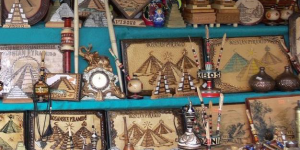Welcome back to another issue of The Post Hole! Sorry to keep you waiting over the last two months. The team have had dissertations and essays to complete for our courses at York. As well as feeling relieved to have completed those assessments, we are excited to release three more issues of The Post Hole before the summer!
In this issue, Arnaud Lambert provides a very interesting interpretation of the use of calendrical glyphs in Olmec-style paintings inside Oxtotitlán cave, Guerrero, Mexico. It is an area of study in archaeology which we feel is of considerable importance to the understanding of interpersonal relations in Mesoamerica during this period and should have greater awareness by researchers internationally.
Internationalisation of archaeological research is something that is discussed by James Preece in this issue. Preece raises a number of important questions concerning the objectivity of archaeologists in interpreting the past and different cultures. These questions are central to archaeological practice yet Preece may be correct to suggest that they are not discussed frequently or in-depth enough across the archaeological community. Most importantly, Preece identifies that how we deal with the inevitability of archaeological interpretations never being fully removed from subjectivity is an even more basic question that still needs answering before any discussion surrounding the nature of such subjectivity in interpretations.
Fabián Fernández informs us of a promising initiative by the Italian Archaetypes International Research (AIR) association. The AIR aims to encourage an integrated collaboration between international researchers and local residents towards documenting and better understanding the archaeology of the Visoko valley in Bosnia and Herzegovina. At a time of increasingly encouraged community participation in archaeological research, what makes this project particularly notable, as explained by Fernández, is that it is actively seeking to progress the protection of largely destroyed cultural heritage in Bosnia and Herzegovina despite continuing, and arguably hasty, arguments between different groups of archaeologists, authorities and locals surrounding the Bosnian pyramids.
As a bioarchaeology student, I will be unashamedly subjective in revealing my pleasure in integrating a bit of science into this issue of The Post Hole! Jessica Hendy, Sophy Charlton and Anita Radini, three PhD students of the University of York BioArCh (Biology, Archaeology and Chemistry) group, introduce us to their exciting research using dental calculus to identify diseases and illnesses not otherwise observed in individuals through osteoarchaeological analysis alone. Their area of research will undoubtedly make an increasingly demanded contribution to archaeology in future years and we look forward to hearing more about the results from their work and its shifting position within the discipline.
Finally, James Metcalf explains why contemporary literature from the 18th century should be used far more by buildings archaeologists to capture a sense of the views of individuals during this period of time. Metcalf postulates that archaeologists are discouraged from using this type of evidence in their work because of the romantic nature of its language. Metcalf is quite insightful in suggesting that there has always been a romantic element in most interpretations of castles, whether by 18th century antiquarians or 20th and even 21st century archaeologists. As concluded by Metcalf, provided evidence is never taken for granted and is utilised, as it should, for discussion of interpretations, 18th century literature has a contribution to make in this area of archaeology.
That is Issue 29! All of the articles in this issue demonstrate the value of integrated archaeology to the understanding of the past. It is also positive that The Post Hole continues to attract a diverse demographic of readers and writers, with this issue alone containing the research and views of one undergraduate student, one Masters student, one Masters graduate, three PhD students and one assistant professor.
However, we are aware that it is still quite rare within academia for the opportunity to be so freely offered for integrated voices of people with such diverse backgrounds. That is why Navid Tomlinson, Taryk Rawlins-Welburn and I have established the Annual Student Archaeology (ASA) Conferences. This will be an annual conference where students will be given the opportunity to platform their research and views on the past to each other and to all other members of the academic discipline.
The 1st Annual Student Archaeology Conference will be held this year at the University of York on the 19-20th June. We have already received an impressive variety of interesting abstracts from students across the UK and even abroad. 27 abstracts have been accepted and we are currently advertising our call for posters which will conclude on the 31st May. We hope our call for posters will allow students from anywhere in the world to contribute their research and views to the debate at ASA1 because we will print and display these for free if they are emailed to us as PDF files before the deadline date above.
We have a number of other exciting initiatives planned for ASA1, including videoing the presentations and offering presenters the opportunity to have their work published in a special conference edition of The Post Hole this summer. The videos will be freely available to anyone, including the public, online shortly following the conference, and the special edition of The Post Hole will be open-access like all other existing content of the journal.
Navid, Taryk and I are very excited about the potential for the Annual Student Archaeology Conferences to further allow a truly Integrated Archaeology to exist for absolutely anyone with an interest in the past. We hope you are just as excited as we are! You can find the latest news about ASA1 on the official conference website and on Facebook and Twitter, at:
Website: www.asaconference.weebly.com
Facebook: www.facebook.com/ASAconference
Twitter: www.twitter.com/ASAconference
Please email contact.asaconference [at] gmail.com if you would like any further information about this exciting initiative or if you would like to get involved with its future organisation... And remember, you have less than three weeks left to submit a poster, if you would like us to print and display it for free!
If you are not presenting a paper at the conference, you can still share your research and views on the past with The Post Hole in one of our ordinary issues! Now is the perfect time for students to publish their completed dissertation research with us, and lecturers, post-doctorate researchers and others are equally welcome to share their work – in fact, we already have one submission from each of these ‘types’ of people for our next issue, so don’t delay, send us your articles to submissions [at] theposthole.org today!
Best wishes,
David Altoft
(Editor-in-Chief of The Post Hole - david.altoft [at] theposthole.org)


